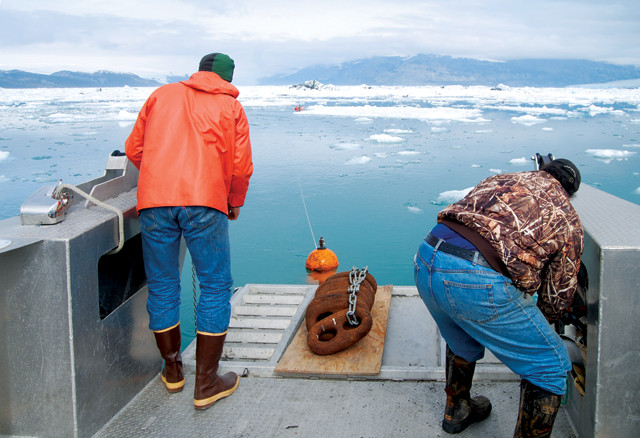
by Timothy Oleson Monday, June 1, 2015

Researchers deploy a hydrophone in Icy Bay, Alaska, to monitor noise levels in the glacial fjord. Credit: Jeffrey Nystuen.
From Antarctica to the Arctic; from polar caps, permafrost and glaciers to ocean-rafted sea ice; and from burly bears to cold-loving microbes, fascinating science is found in every nook and crevasse of Earth’s cryosphere, and new findings are announced often. Here are a few of the latest updates.
The extent of Arctic sea ice this past winter maxed out on Feb. 25, 2015, at 14.54 million square kilometers, marking a new record low since satellite records began, according to the National Snow and Ice Data Center (NSIDC). This year’s maximum extent fell short of the previous record low of 14.67 million square kilometers, set in 2011, and was 7 percent below the 1981-to-2010 average. The NSIDC suggested that one contributor to the low sea-ice extent was “an unusual configuration of the jet stream [in February], leading to warm conditions over the Pacific side of the Arctic that maintained low sea-ice extent in the Bering Sea and the Sea of Okhotsk.”
If you’ve ever seen icebergs calving into the sea, you’ve likely heard the deep rumbling and piercing crackles emitted during these impThese sounds are also picked up underwater by hydroacoustic sensors, which, according to a new study, can tell the type of calving event based on the sorts of sounds it makes. Scientists led by <a higf.edu.pl/oskar-glowacki.php">Oskar Glowacki of the Polish Academy of Sciences in Warsaw studied icebergs calving into Hornsund Fjord from Hans Glacier on the Norwegian island of Svalbard in 2013, filming the events above the water and recording the submarine sounds they produced with a hydrophone. From the acoustic data, they could distinguish three types of calving: the most common, in which blocks of ice broke from the glacier and fell directly into the water; those in which blocks scraped along the glacier’s leading edge before hitting the water; and events in which a block broke from the submerged portion of the glacier and rose to the water surface. The results demonstrate the usefulness of hydroacoustic methods in monitoring the timing, scale and mode of iceberg calving — particularly where continuous vns are impractical — the researchers noted in Geophysical Research Letters. This is important for quantifying both mass loss from glaciers and the hazard for seafaring humans. Video of some of the observed calving events can be seen here: http://bit.ly/19nSLKD.
In a similar study also published in Geophysical Research Letters, a team captured the full range of submarine sounds in glaciated fjords in Alaska and Antarctica. Erin Pettit of the University of Alaska at Fairbanks and her colleagues reported that such fjords appear to be the noisiest places in the ocean, with the average thrum exceeding noise levels produced by surface weather, the movements and communication of sealife, and even human-generated sources like ships and sonar. Although iceberg calving contributes occasional loud bursts to the noisy fjords, the main source is the constant gurgling of ice-entrapped air bubbles as they’re released from melting glaciers and icebergs. As melting rates change, noise levels will also change, the researchers suggested, possibly impacting the behavior of marine life. Listen to audio recordings from fjords in Alaska and Antarctica here: http://bit.ly/191fo7Y.
If the Greenland Ice Sheet were to melt entirely, the enormous volume of liberated freshwater would lead to about 7 meters of global sea-level rise. In addition, the glacial runoff could dramatically influence Northern Hemisphere climate because of its effect on the Atlantic Meridional Overturning Circulation (AMOC), a major component in global ocean circulation. But, even without considering all that freshwater, new research confirms that the disappearance of the ice sheet — a formidable feature about 2.5 times the size of Texas and with a maximum elevation of 3.2 kilometers — would substantially affect climate due to the drastic changes in the island’s topography. Running a high-resolution climate model in which the surface of the ice sheet was replaced by Greenland’s bedrock topography, Paolo Davini of the Institute of Atmospheric Sciences and Climate in Turin, Italy, and colleagues found that wind patterns and heat transport over the North Atlantic shifted significantly in response to the missing ice sheet. Through a domino effect, the changing winds impacted regional ocean circulation and salinity, and induced a 12-percent slowdown of the AMOC, the team reported in Geophysical Research Letters.
© 2008-2021. All rights reserved. Any copying, redistribution or retransmission of any of the contents of this service without the expressed written permission of the American Geosciences Institute is expressly prohibited. Click here for all copyright requests.